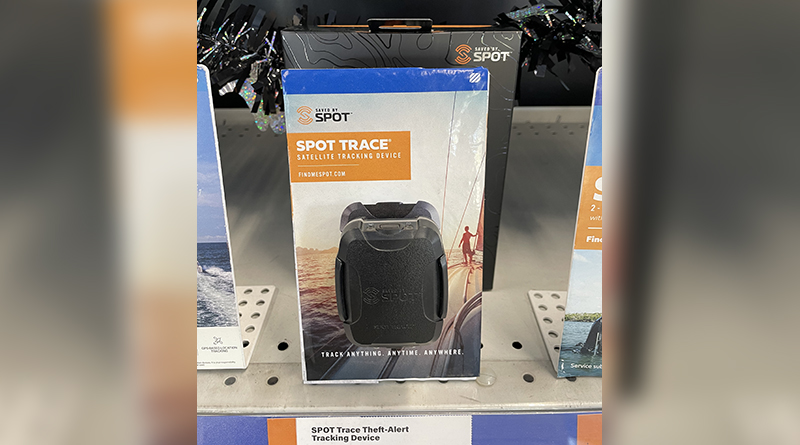When asked what summer weather is like in the Sea of Cortez, we can always reply, “It’s going to be hotter than you can imagine! Ha ha!” And this year, with so many record-breaking air and sea temperatures all across North America, Mexico’s Sonora Desert might be, well, unimaginable.
I used to add, “If we get any summer wind at all, it’s going to be from the south.” But that’s not 100 percent true either. Here’s why.
SUMMER WINDS
Sailing boaters and power boaters both pay close attention to predicted wind velocity and direction. During early and mid-summer, say June, July and early August, we sometimes get forecasts calling for light southerlies “on and off” all along the Sea of Cortez (hence forth to be called the Gulf of California).
What causes summer southerlies? It’s a semi-permanent area of low pressure that sits over Yuma, Arizona, at the top of the Gulf of California, known as the “Yuma Low.” Like an attic fan in a house, this low pressure actually sucks air up through the relatively narrow axis of the Gulf of California – like a giant straw.
YUMA LOW
If it’s an average to deep low, like 1010 millibars, its effect starts in the north end of the Gulf of California around Puerto Penasco or San Felipe, then continues sucking from the Midriff Islands and on down from San Carlos and Santa Rosalia. A really strong Yuma Low can eventually draw hot air up from as far south as La Paz and Mazatlan.
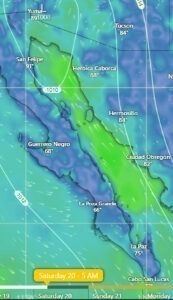
(By the way, I highly recommend boaters get Windy.com premium to assist with weather forecasting and graphic navigation.)
The only folks who could possibly mind the “off” part of the on-and-off southerlies are the Millers, with their smallest of cruising sailboats.
The Millers had planned to use the next southerly to sail their small boat from Santa Rosalia, BCS, across the gulf to San Carlos, Sonora. They could make that 70 n.m. distance in an easy 24-hour run – if they can maintain just a 3-knots SOG. The plan is to leave at sunset on Monday, arrive San Carlos at sunset on Tuesday. Piece of cake with their new drifter!
But what if the Millers encounter the “off” part; zero wind? There’s almost zero commercial traffic on that route since the ferry closed, so they won’t risk a collision if they have to drift around out there for hours. They might even catch a nice dorado as the water warms. But they would have to make landfall at San Carlos in the dark so might have to wait for daylight to pick their way into the unfamiliar port.
Speaking of fishing, the fishing folks love summer southerlies, because they come with warmer water temperatures, and that brings up the big pelagic species from the south, like dorado, marlin and other billfish. Summer billfish tournaments about from Los Cabos and La Paz, up to Puerto Escondido, Mazatlan and San Carlos.
CHUBASCO
This term refers to a localized summer squall, not to a hurricane or huricáno. Chubascos occur in coastal waters directly below mountains. During afternoons, heat builds up and unleashes thunderstorms and lightning that rage all night.
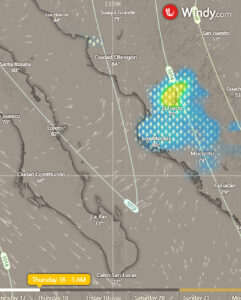
The storm becomes a chubasco when it tumbles rapidly downhill and lands on the coastline, sometimes dropping the air temps by 10°F.
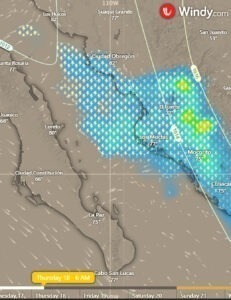
Surprised folks down there may have seen only the anvil tops of cumulo-nimbus clouds sparked by heat lightning. They didn’t hear the loud thunder claps if they were more than 10 miles away. Thus a chubasco can surprise unwary coastal sailors with its almost instant blasts of strong cold wind from all directions at once, even straight down, along with patches of intense rain and bolt lightning. Chubascos are intense and dramatic but of short duration.
GAP WINDS
The mountainous Baja California Peninsula usually does an excellent job shielding Sea of Cortez waters from stronger Pacific Ocean conditions. Except where it doesn’t.
When prevailing Northwesterlies reach 20 knots or more, they can bridge a few infamous low and narrow spots or gaps atop Baja’s rugged spine – depending also on how northerly or westerly direction they blow.
See the Windy depicting three gap-wind examples on the same day.
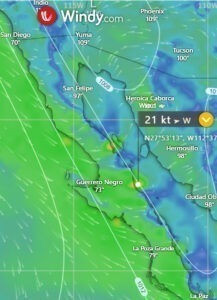
First they are funneling down on the popular summer cruising grounds at Bahia de Los Angeles in northern Baja. Then you see 21 knots blowing down on La Trinidad, which is about in the middle of the 70 n.m. undeveloped coast between Santa Rosalia and San Francisquito. Finally it shows lesser gap winds blowing down on Ensenada Blanca, just south of Puerto Escondido.
“Elefante” refers to a telltale rolling white cloud perched up on a “gap” ridgeline. It looks sort of like an elephant’s trunk. When you see one, take your awnings down quick, because a gap-wind event is starting, and it’s going to hoot.
EL CORUMUEL
The La Paz area gets a unique summer wind known as “El Corumuel,” or koh-rum-WELL. Legend says locals named this wind after a stealthy English pirate (Cromwell) who would raid the Spanish ships only during the night, then sneak away at sunrise.
This wind phenomenon starts on the Pacific something like a gap wind, but this gap is much broader, not narrowly funneled. By the time it reaches La Paz, it’s a delightfully cool night breeze that starts about sunset, usually stays steady all night, then dies at sunrise.
It’s difficult to predict a Corumuel, but they’re usually welcomed, because they carry away excess heat and humidity of the summer day, making sleeping below decks more comfortable without air conditioning.
WHERE TO GO WHEN WINDS BLOW?
We’re glad to hear that La Niña may lessen our risk of hurricane disasters, but at this time of year, boaters who are summering over will be moving north in the Gulf of California. My little map shows some interesting areas for boaters to visit (pink circles) and other interesting places to visit that also have quick access to a hurricane hole (red circles).
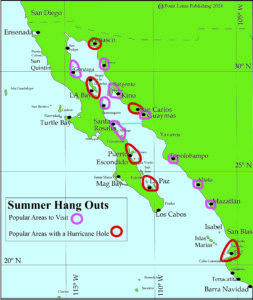
Marina Puerto Escondido has been approved by SEMARNAT to build four new docks, eventually increasing their capacity by 81 new slips. Construction is expected to take seven years.
FYI: Pacific Hurricane Names for 2024 are Aletta, Bud, Carlotta, Daniel, Emilia, Fabio, Gilma, Héctor, Ileana, John, Kristy, Lane, Miriam, Norman, Olivia, Paul, Rosa, Sergio, Tara, Vicente, Willa, Xavier, Yolanda and Zeke.







